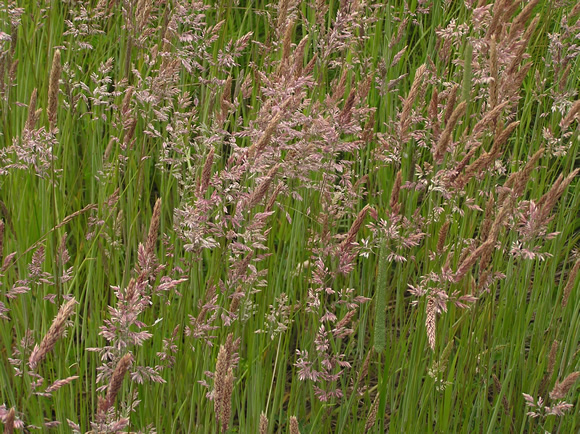|
There are so many grasses that we walk on, walk over or walk through, and except for the odd one, never notice them. Like the wildflowers, the casual stroller never notices the grass until the blooms appear. |
| |
|
 |
Grass is very similar to wildflowers being more noticeable when in flower, although the taller grasses can catch your attention when the flower heads sway in
the wake of the slightest breeze. |
| |
 |
|
 |
The image above shows the natural beauty of Smooth Brome, Bromus racemosus, which many of us take for granted often ignoring it completely. It's a tall grass that can reach four feet in height. The florets of this grass are mostly small, closed and self-ferterlizing. |
|
Above we have the Annual Meadow Grass, Poa annua, an annual that roots at the nodes and forms small mats. It is very common in disturbed sites and open habitats at low elevations. It is most suitable for lawns and is used on many golf putting greens. |
| |
|
|
 |
|
 |
Sweet Vernalgrass, Anthoxanthum odoratum, is a tufted and sweet-scented perennial grass that has adapted well to many different habitats. It can be found in pastures and open forests and the sides of roads. It does however, grow better in the drier climates of its established locations. |
| |
|
|
 |
|
 |
Children love to pull off the flower heads of this grass and and through them at the backs of their friends like darts, where they would cling to clothing. It is called Wall Barley, Hordeum murinum. The flowers have both male and female parts and are pollinated by the wind. It can't grow well in shade and requires well drained soils. |
| |
|
|
 |
Bristly Dogstail Grass, Cynosurus echinatus, is another attractive tufted annual grass that enjoys the openess of clearings, the meadows and the edges of the forests. It grows less than two feet in height and prefers lower elevations. |
| |
|
A strange name for a grass is Yorkshire Fog, Holcus lanatus. It is a tufted perennial grass and is well adapted to growing in wet conditions but can also survive a moderate drought. |
|











